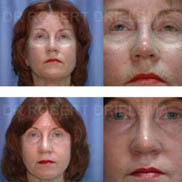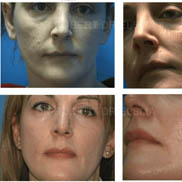
There are three ways to achieve effective skin ablation for resurfacing.
These are:
a) Chemical peeling, whereby an acid is used to burn into the skin layers: this is effective but messy and lacks control.
b) Dermabrasion whereby a physical abrasion with a burr denudes the skin: again this is messy and not that controlled – but when done effectively works well
c) Laser ablation whereby a high powered focused beam of light ablates skin layers into the dermis : because the light beam seals blood vessels, this is a relatively clean and neat procedure. Also, because the amount of energy delivered to the skin can be carefully controlled, this is a relatively precise technique with accurate control of the depth of ablation achieved.
Laser Resurfacing is now preferred to dermabrasion and chemical peel or can be used in conjunction with other facial rejuvenation procedures.
The effectiveness of laser resurfacing depends on the level of ablation into the dermis. A deep resurfacing into the mid dermis will give the most effective result. This depth of burn is associated with a raw skin (like sunburn) healing phase of 7 to 10 days and a subsequent period of skin redness for a further 3 to 4 weeks. Commonly used lasers that can readily achieve the depth of burn to achieve adequate results include the carbon dioxide (Co2), erbium lasers and modern ablative FRAXEL lasers. Q-swith ruby lasers can give a gentler treatment with short downtime recovery.
The laser has greater advantages over the older methods in accuracy and precision. The laser allows the skin to be vaporised in a controlled method layer by layer.
Before and After Gallery
Laser Resurfacing




Meet our Specialist Plastic Surgeon Dr Robert Drielsma
MBBS, BSc(Med), FRACS
(AHPRA MED00001073756)
Dr Drielsma is an Australian trained Specialist Plastic Surgeon with over 30 years of extensive experience in plastic surgery of the face, breasts and body. He is a fellow of the Royal Australasian College of Surgeons (FRACS), a member of the Australian Society of Plastic Surgeons (ASPS) and a member of the Australian Society of Aesthetic Plastic Surgeons (ASAPS)

Laser Resurfacing FAQ
- What are the advantages of laser?
- Am I suitable for laser resurfacing?
- How long does it take?
- Is hospitalisation required?
- Does it hurt?
- What should I expect after surgery?
- Will my skin be more sensitive?
- Is this permanent?
- Are there any complications that may occur?
-
Next Step
- Next Step : Book your Initial Consultation
- What to Bring to your Surgeon Consultation
- Want more information before scheduling your Surgeon consultation?
**Individual results may vary. All surgery carries risks.
You should seek a second opinion from an equally qualified Specialist Plastic Surgeon before proceeding with surgery.
20 year old woman - Total Rhinoplasty. Removal of nose "bump" and refinement of nasal tip.
Post operative photos shown 3 months following surgery
Individual results may vary. All surgeries carry potential risks and complications. You should seek the opinion of a fully qualified Specialist Plastic Surgeon before proceeding with surgery. Dr Drielsma is a fully qualified Specialist Plastic Surgeon. (AHPRA - MED0001073756)
.
.
.
#breastreduction #breastlift #lollipopbreastreduction #lollipopbreastlift #internalbrasling #plasticsurgeonsydney #plasticsurgeonwagga #plasticsurgeoncanberra #plasticsurgeoncamden #bodylift #tummytuck

Understanding Breast Reduction & Lift Procedures ✨
Did you know there are different techniques for breast reduction and lift? 🤔 Let’s break down the Lollipop vs. Anchorprocedures, and why Dr. Drielsma’s signature Lollipop Breast Reduction & Lift stands out!
🔹 Lollipop Breast Reduction & Lift: This technique uses a small incision around the areola and a vertical line beneath it, creating a “lollipop” shape. It’s perfect for those looking for a lift with minimal scarring and a more youthful, natural appearance.
🔹 Anchor Breast Reduction & Lift: The traditional method, involving three incisions: around the areola, down to the crease, and along the breast fold. This is ideal for patients with more significant sagging or excess skin.
✨ Why Dr. Drielsma’s Lollipop Technique?
Dr. Drielsma’s signature Lollipop Breast Reduction & Lift combines precision and artistry, giving you stunning results with less scarring and faster recovery. The technique is perfect for those who want to reduce volume and achieve a more firm, all natural and raised breast appearance.
Interested in learning more? DM us or book a consultation today! 🩺💕
.
.
.
#BreastReduction #BreastLift #LollipopLift #AnchorLift #DrDrielsma #SignatureTechnique #PlasticSurgery #BreastAugmentation #BodyConfidence

-Natural Shape
-Natural Size
-Natural Result
No implants. No boxy breasts.
Just Dr Drielsma’s signature, minimal scarring, lollipop breast reduction.
160 grams removed from the right
200 grams removed from the left
.
.
.
Individual results will vary according to factors including genetics, age, diet and exercise. All surgery carries risks and requires a recovery period and care regime including wearing of post operative garments. More information is available from the relevant procedure page on our website. You should seek a second opinion from a Specialist Surgeon before proceeding. Dr Drielsma is a Specialist Plastic Surgeon - AHPRA Registration: MED0001073756.
.
.
.
#breastreduction #breastlift #lollipopbreastreduction #lollipopbreastlift #internalbrasling #plasticsurgeonsydney #plasticsurgeonwagga #plasticsurgeoncanberra #plasticsurgeoncamden #bodylift #tummytuck

Busy day in the operating theatre.
.
.
.
#breastreduction #breastlift #lollipopbreastreduction #lollipopbreastlift #internalbrasling #plasticsurgeonsydney #plasticsurgeonwagga #plasticsurgeoncanberra #plasticsurgeoncamden #bodylift #tummytuck

The ⭐ combo = Dr Drielsma’s signature, minimal scarring breast reduction & lift.
No implants were used to archive this natural shape and elevation.
Tell us how much weight you think was removed from each breast.
Drop your guess 👇 in the comments.
📷 Post op photo taken 3 months after surgery.
.
.
.
Individual results will vary according to factors including genetics, age, diet and exercise. All surgery carries risks and requires a recovery period and care regime including wearing of post operative garments. More information is available from the relevant procedure page on our website. You should seek a second opinion from a Specialist Surgeon before proceeding. Dr Drielsma is a Specialist Plastic Surgeon - AHPRA Registration: MED0001073756.
#breastreduction #breastlift #lollipopbreastreduction #lollipopbreastlift #internalbrasling #plasticsurgeonsydney #plasticsurgeonwagga #plasticsurgeoncanberra #plasticsurgeoncamden #bodylift #tummytuck



 Before & After
Before & After







